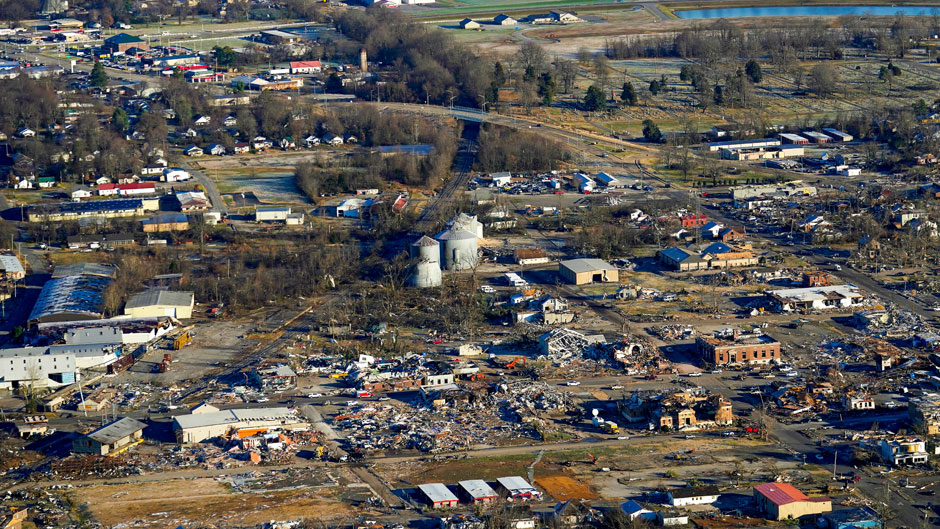‘Devastation like none of us have ever seen before’
Robert C. Jones Jr., 12-13-2021

Kentucky Gov. Andy Beshear didn’t mince words. “It’s devastation like none of us have ever seen before,” he said Sunday on CBS News’ Face the Nation.
Beshear was referring to the destructive flurry of tornadoes that ripped through six states late Friday, killing at least 90 people, knocking out power, and destroying scores of homes and buildings, with the Bluegrass State the hardest hit.
In the small town of Mayfield, a twister flattened a candle factory, where more than 100 people were working inside. As of Sunday, 40 individuals had been rescued from the building.
Beshear reported that at least 70 people had perished in the state and warned that the death toll could rise.
Meanwhile, six deaths were reported after a roof collapsed at an Amazon warehouse in Illinois. And officials in Arkansas, Missouri, Mississippi, and Tennessee also reported storm damage.
One question that may come to mind: Is there a link between the deadly tornado outbreak and climate change?
“Climate plays a role in setting the stage for all these events,” said Amy Clement, a professor of atmospheric sciences at the University of Miami Rosenstiel School of Marine and Atmospheric Science. “But some aspects of weather, like heavy rain and temperature and drought, are easier to connect to climate change than are tornados and extreme wind events.”
What is known, however, is that while tornadoes can occur anywhere in the world, the U.S. has the highest frequency of these extreme weather events, with about 1,200 hitting the nation yearly, according to the National Oceanic and Atmospheric Administration’s National Severe Storms Laboratory.
They are spawned from supercell thunderstorms. “As those of us who live in South Florida know, thunderstorms are very unpredictable—they can appear very quickly, and also disappear quickly,” said David Nolan, professor and chair of atmospheric sciences at the Rosenstiel School, who is an expert on hurricanes, tropical meteorology, computer modeling of weather phenomena, and tornadoes.
“Tornadoes can focus the energy of a thunderstorm into a very small area,” Nolan explained. “While the strongest gusts in tornadoes can be stronger than in any hurricane, the area covered by these extreme winds is tiny compared to hurricanes. Top-of-the-chart EF5 tornadoes, which have gusts exceeding 200 mph, are very rare—less than 0.1 percent of all tornadoes.”
But while it is nearly impossible to predict the formation and path of individual thunderstorms or tornadoes, warning systems have “improved tremendously in the last 20 years, and people often have 20 minutes of warning time,” he said. “The radar technology for tornado detection and warning is amazing.”
Still, tornadoes can present a daunting challenge for emergency managers. “It really does boil down to time,” said Matthew Shpiner, the University’s executive director of emergency management. “Especially given that this [outbreak] occurred overnight, the challenge isn’t just time to act but time to receive information to act upon. Different types of hazards give different planning windows, which may range from seconds when thinking about something like an active shooter to minutes when considering a hazard like tornadoes or days when talking about a hurricane.”
Through his research, Nolan is helping to demystify some of the mysteries surrounding these narrow, violently rotating columns of air. Using computer simulations, he and his research group confirmed that the most extreme winds occur in narrow tornadoes, which means that the area covered by these extreme winds is very small. “We also found amazingly strong updrafts starting very low to the ground—for example, upward winds exceeding 100 mph just 30 feet above the ground,” he said. “This helps us to understand how large debris objects can be lifted into the air.”
Nolan has had at least one close encounter with a tornado—all for the advancement of science. “Ten years ago, I was storm-chasing with friends in Colorado, and we saw a tornado that touched the ground for about 10 seconds,” he recalled. “At that point in our adventure, we had already driven 900 miles in two days looking for tornadoes. So that gives you an idea of how rare they actually are.”